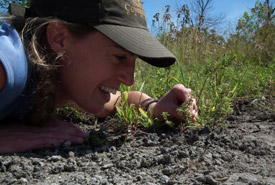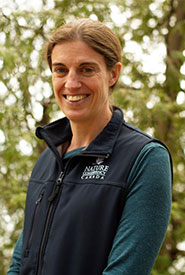Jetbead: A new threat to conservation

Mhairi McFarlane with leucospora (Photo by NCC)
Conservation is full of mysteries. Recently, my colleague Jill Crosthwaithe and I found ourselves having to turn to gardening literature in order to identify the many non-native, ornamental shrubs and other plants that we kept stumbling across in the Nature Conservancy of Canada's (NCC's) Lathrop property. Without flowers or fruits, there are few clues to help us identify plants. If we get to the property at the wrong time of year, all we have are leaves. Furthermore, many of our field guides do not cover ornamental species, especially those that have not become known invasives yet, and even a lot of creative "googling" doesn't always work.
As a result, every trip to Lathrop comes with the feeling of, "oh no, what are we not going to be able to identify this time?!"
Two years ago, as we walked the trails, checking for litter and fallen branches or trees, and monitored the progress of some previous invasive species control efforts, we came across a rather pretty shrub with actual flowers on it! Of course we figured "It has flowers, how hard can it be?"....But we were stumped. So we took a number of photographs and a small sample showing the arrangement of the leaves and a flower. Back at the office, we pressed it and showed it to Jane Bowles (who ran the University of Western Ontario herbarium but sadly passed away last summer), and she identified it as jetbead (Rhodotypos scandens).
Now armed with a name, we could learn more about our shrub. As we had strongly suspected anyway, Jetbead is not native to Ontario, but to China.
The best time to control non-native invasive shrubs is after they have flowered, later on in the summer. Unfortunately, we were unable to add it to our "killing list" for shrub season 2012, but we did for 2013. In mid-october of last year, Jill and I visited the property to check some of the trails and to remove non native shrubs. We removed all of the jetbead we were aware of, either by uprooting it, or, for the bigger ones, by cutting the stems at ground level and spraying the cut stems with a 20 per cent glyphosate solution (Jill and I are trained, licensed "Forestry Exterminators," so we are able to use regulated herbicides for this sort of work to improve forest biodiversity).
We plan to revisit the property this spring to check for resprouting and to document any individuals we missed, and will conduct any follow-up control necessary this fall. Because the shrubs have been there for a few years, we know there must be seeds in the soil, so we expect to have to remove seedlings for a few years. This highlights the importance of repeated follow-up visits to our properties and especially to the areas where we have conducted stewardship.
The removal of non-native invasive species such as these is very important in our natural areas. Invasive species can outcompete native plants, meaning that you can end up with large patches with only one or two species of plant. This in turn means that fewer invertebrates can complete their lifecycles, because their native host plants are no longer present (think monarchs and milkweeds — there are many other tight relationships like this between invertebrates and plants). This then reduces bird breeding success. Most birds (even hummingbirds) feed their young on invertebrates at some point in their development. Less plant diversity and more invasive species cover means less invertebrate diversity and density, which means less food for everyone else (the same argument could apply to small mammals, reptiles, amphibians, etc., all of which are either directly or indirectly dependent on invertebrates).
Removing an invasive species before it has spread too far is obviously the most cost-effective way to address the issue. Our eradication work only took about a day of staff time on the ground. If we had left it for another few years, its possible it would take many, many days of staff time to eradicate (in fact, we face this problem with several other invasive species on this same property). This is one of the key reasons we commit to visiting our properties at least once each year. We make sure to examine the edges, and areas where people have access, as these points are obvious conduits for new invasives to arrive and establish.


